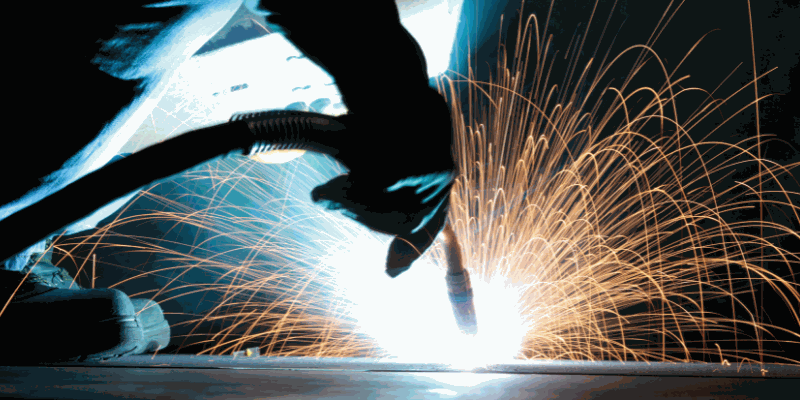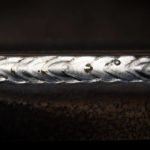MIG welding is a process that uses a wire electrode to create a weld. So, why is DC used in MIG welding? DC is used in MIG welding because it has a broader welding range than AC, meaning it can be used to weld a wider range of materials. Additionally, DC produces deeper weld penetration and fewer spatters than AC.
While both AC and DC have their benefits, most welders prefer to use DC for MIG welding because of its superior performance. If you’re looking to get started with MIG welding, be sure to learn about the different types of welding current and pick the one that is best suited for your project.
Contents
What is MIG welding?
MIG welding is a type of welding that uses an electric arc to join metals. The acronym “MIG” stands for “metal inert gas.” This refers to the fact that MIG welding uses an inert gas, such as argon, to protect the weld from contamination.
MIG welding is a relatively easy process to learn, and it can be used to weld a variety of metals, including aluminum, stainless steel, and even cast iron.
One of the main advantages of MIG welding is that it can be used on thin materials without the need for filler material. This makes MIG welding ideal for applications where appearance is important, such as in automotive bodywork.
In addition, MIG welding is typically faster than other types of welding, making it less time-consuming and more cost-effective.

How does MIG welding works?
MIG welding works by using an electrode to create an arc between the metal being welded and the electrode. This arc causes the metal to melt, and as the electrode is moved along the metal, a bead of weld is created. MIG welding is a relatively easy type of welding to learn, and it can be used on a variety of different metals. One downside of MIG welding is that it can be difficult to weld thick pieces of metal, as the heat from the arc can cause the metal to warp. However, MIG welding is still a versatile and widely-used type of welding.
However, ac/dc MIG welders offer the best of both worlds, providing the stability of dc with the flexibility of ac. As a result, they are a popular choice for many welders. Whether you choose a dc or ac/dc MIG welder, you can be confident that you’ll be able to produce high-quality welds.
What is meant by the direct current?
Direct current (DC) is an electric current that flows consistently in one direction. This is in contrast to alternating current (AC), which reverses direction at regular intervals. DC is often used in electronic circuits, as it can provide a constant power supply.DC can be generated by chemical sources such as batteries, or by electromechanical sources such as generators. It can also be transmitted through metal wires using electroplating. In household applications, direct current is often provided by batteries, solar panels, or fuel cells.
AC, on the other hand, is most commonly transmitted through long-distance power lines. While DC has some advantages over AC, it is not always the best choice for every application.
The electricity for the arc comes from a DC power source, which provides a steady flow of electrons. This type of power is well suited for MIG welding because it helps to create a stable arc that is less likely to wander or sputter. In addition, DC current can be used to weld metals of different thicknesses and compositions. As a result, DC is the preferred choice for many MIG welding applications.
Reasons why DC is used in MIG welding
Here are some most common reasons why you should use DC in MIG weldings
- The DC electrode polarity produces a more stable arc, which is less likely to wander and makes it easier to control the weld pool.
- DC provides a more consistent welding current, which results in better weld quality and less chance of error.
- It is less likely to cause spatter than AC, making it ideal for use in thin materials or when a smooth, professional finish is desired.
- DC can be used with a wider range of electrode types, including those that are coated with flux or metal powder. This gives the welder more options for different applications.
- DC welding is generally faster than AC welding, due to the more efficient transfer of heat from the electrode to the workpiece. This can be a significant advantage when welding large areas or thick materials.
- It is less likely to cause metal oxidation than AC welding, making it ideal for use in situations where a clean, polished finish is desired.
- DC welding is less affected by wind and other environmental factors than AC welding, making it more versatile and easier to use in outdoor applications.
Benefits of using Direct current in MIG welding
There are many benefits to using direct current in MIG welding, such as:
Increased control
With direct current, the welder has much more control over the arc and can produce a steadier, more consistent weld.
Greater penetration
The direct current produces a hotter arc, which penetrates the metal more deeply and creates a stronger weld.
More flexibility
Direct current can be used on a variety of metals, including aluminum and stainless steel.
Faster welding speed
Because the arc is hotter, it melts the metal faster, making for a quicker overall welding process.
Reduced costs
In many cases, direct current is more cost-effective than other types of welding, due to the increased efficiency and productivity.
Why is DC preferred more than AC in MIG welding?
In any welding process, an electric current is used to create an arc between the metal being welded and the electrode. This arc is what produces the heat needed to melt the metal and join the two pieces together. When using MIG welding, there are two main types of electric current that can be used – direct current (DC) or alternating current (AC).
DC is the more popular choice for MIG welding, as it provides a number of advantages over AC. First, DC produces a more stable arc, which makes it easier to maintain a consistent weld bead. Second, DC is less likely to cause arc blow, a phenomenon that can cause the weld bead to be distorted.
Finally, DC is less likely to cause electrode melting, meaning that fewer electrodes need to be replaced during the welding process. For these reasons, DC is generally the preferred choice for MIG welding.
Applications of MIG welding
MIG welding is commonly used in a wide range of applications, including automotive, construction, and general fabrication. It is frequently used to weld thinner materials and can be used on both ferrous and non-ferrous metals.
Some of the most common applications for MIG welding include:
Automotive
Automotive manufacturing often uses MIG welding to join smaller metal components. It is also commonly used to repair cars and trucks.
Construction
MIG welding is frequently used in construction projects, especially when working with thinner metals. It can be used to create structural supports, as well as to weld together pipes and other metal components.
General fabrication
General fabricators often use MIG welding for a variety of projects. This could include anything from creating metal sculptures to welding together parts for machinery.
Conclusion
So, what’s the verdict? Why is DC used in MIG welding? The answer is simple – it provides a stable and smooth arc which results in high-quality welds.
By understanding the principles behind DC, you can make sure your welds are of the best possible quality. Ready to try out MIG welding with DC for yourself? This article will help you a lot.






